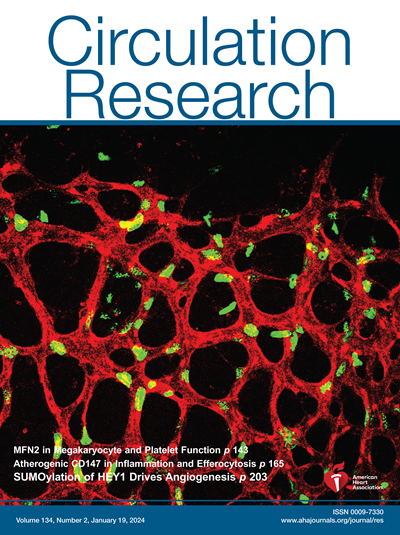High-Throughput Echocardiography-Guided Induction of Myocardial Ischemia/Reperfusion in Mice.
IF 16.5
1区 医学
Q1 CARDIAC & CARDIOVASCULAR SYSTEMS
引用次数: 0
Abstract
BACKGROUND Mouse models of myocardial ischemia with subsequent heart failure are common approaches to examine heart failure pathology and possible treatment strategies. We sought to establish a high-throughput approach for echocardiography-guided induction of myocardial ischemia/reperfusion (IR) in mice. METHODS After visualization of the left coronary artery with high-resolution ultrasound imaging and echocardiographic definition of the level of coronary occlusion, the left anterior descending artery was temporarily occluded with 2 micromanipulator-controlled needles. Functional and molecular changes were assessed and compared with commonly performed surgical techniques. RESULTS Echocardiography-guided induction of myocardial IR enabled standardized induction of myocardial IR injury with subsequent left ventricular remodeling. Incorporation of various quality control measures throughout the procedure ensured a high success rate and the absence of relevant postinterventional mortality in experienced hands. Compared with surgical approaches, echocardiography-guided induction of myocardial IR showed a quicker recovery time and induced a less pronounced inflammatory response characterized by decreased local and systemic neutrophil counts. Notably, infarct size and subsequent post-myocardial infarction cardiac dysfunction were comparable between methods. The novel procedure was successfully implemented at different academic institutions with imaging expertise and demonstrated high interinstitutional reproducibility. CONCLUSIONS Echocardiography-guided induction of myocardial IR enables high-throughput induction of myocardial IR injury with precise echocardiographic definition of the occlusion level and immediate evaluation of cardiac function during ischemia. The method provides a more clinically relevant assessment of IR sequelae and offers notable animal welfare advantages by eliminating the need for ventilation and thoracotomy, thereby mitigating potential surgery-related confounders.高通量超声心动图引导诱导小鼠心肌缺血/再灌注。
小鼠心肌缺血并发心力衰竭模型是研究心力衰竭病理和可能的治疗策略的常用方法。我们试图建立超声心动图引导下小鼠心肌缺血/再灌注(IR)诱导的高通量方法。方法采用高分辨率超声显像显示左冠状动脉,超声心动图明确冠状动脉闭塞程度后,用2根微操纵针暂时闭塞左前降支。评估和比较常用手术技术的功能和分子变化。结果超声心动图引导下的心肌IR诱导能够标准化地诱导心肌IR损伤并随后左心室重构。在整个手术过程中纳入各种质量控制措施,确保了高成功率,并且在经验丰富的人员中没有相关的介入后死亡率。与手术方法相比,超声心动图引导下的心肌IR诱导恢复时间更快,炎症反应不明显,其特征是局部和全身中性粒细胞计数减少。值得注意的是,梗死面积和随后的心肌梗死后心功能障碍在两种方法之间具有可比性。该新方法在不同的学术机构成功实施,具有成像专业知识,并显示出高机构间的可重复性。结论超声心动图引导心肌IR诱导能够高通量诱导心肌IR损伤,超声心动图可精确定义心肌缺血时的闭塞程度,并可即时评估心肌功能。该方法为IR后遗症提供了更具临床相关性的评估,并通过消除通气和开胸的需要,从而减少了潜在的手术相关混杂因素,从而提供了显著的动物福利优势。
本文章由计算机程序翻译,如有差异,请以英文原文为准。
求助全文
约1分钟内获得全文
求助全文
来源期刊

Circulation research
医学-外周血管病
CiteScore
29.60
自引率
2.00%
发文量
535
审稿时长
3-6 weeks
期刊介绍:
Circulation Research is a peer-reviewed journal that serves as a forum for the highest quality research in basic cardiovascular biology. The journal publishes studies that utilize state-of-the-art approaches to investigate mechanisms of human disease, as well as translational and clinical research that provide fundamental insights into the basis of disease and the mechanism of therapies.
Circulation Research has a broad audience that includes clinical and academic cardiologists, basic cardiovascular scientists, physiologists, cellular and molecular biologists, and cardiovascular pharmacologists. The journal aims to advance the understanding of cardiovascular biology and disease by disseminating cutting-edge research to these diverse communities.
In terms of indexing, Circulation Research is included in several prominent scientific databases, including BIOSIS, CAB Abstracts, Chemical Abstracts, Current Contents, EMBASE, and MEDLINE. This ensures that the journal's articles are easily discoverable and accessible to researchers in the field.
Overall, Circulation Research is a reputable publication that attracts high-quality research and provides a platform for the dissemination of important findings in basic cardiovascular biology and its translational and clinical applications.
 求助内容:
求助内容: 应助结果提醒方式:
应助结果提醒方式:


